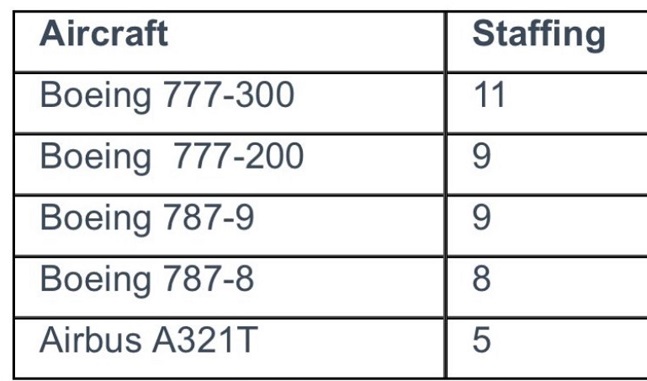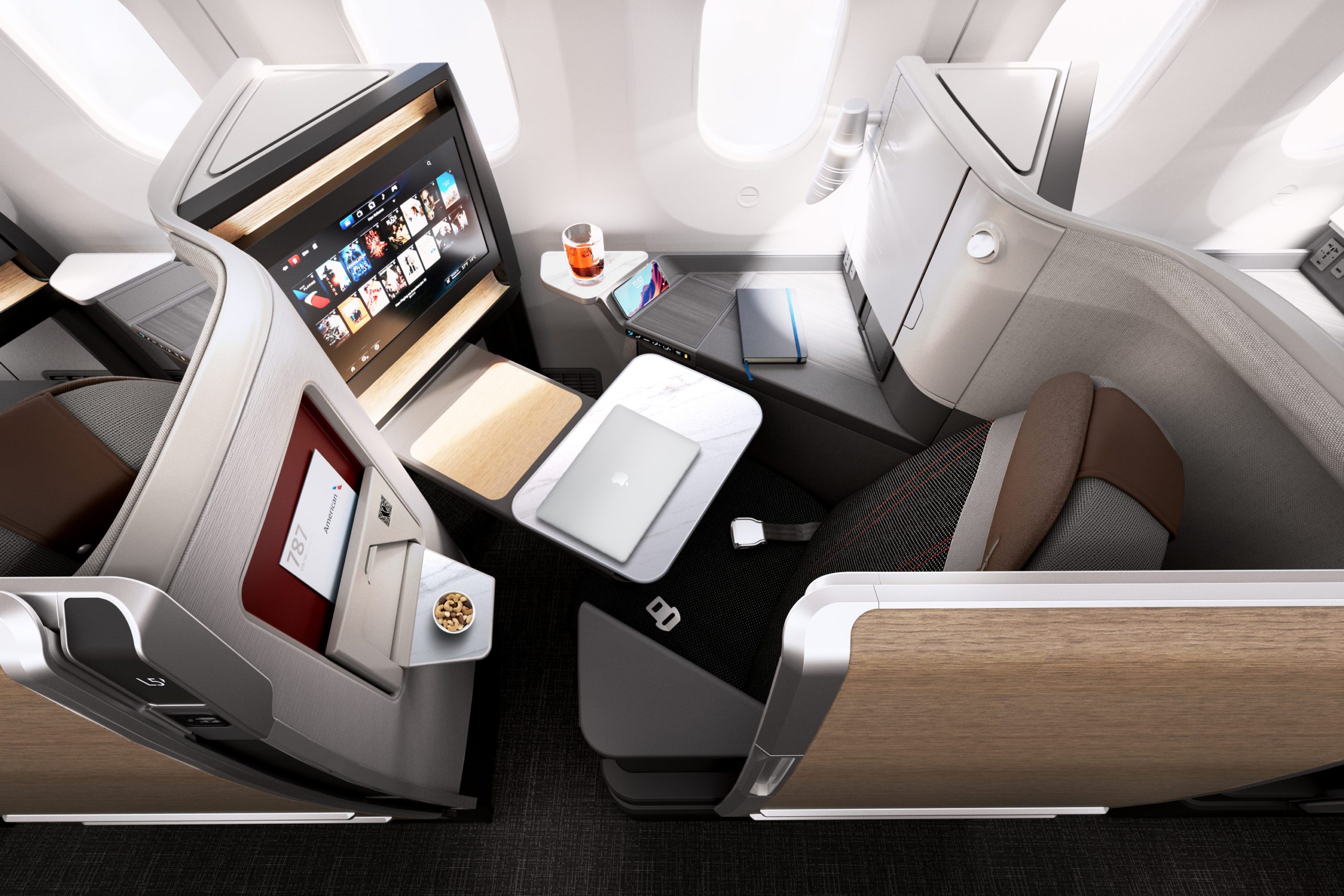It’s interesting to look at what American Airlines flight attendants didn’t get in their negotiations. They’re going to get boarding pay – they’ll be paid for the time spent boarding an aircraft – but that doesn’t start until six months after the contract is ratified. They’re going to get higher 401(k) contributions, but that doesn’t start until 2025. They aren’t going to get higher staffing levels. They won’t even get pre-pandemic staffing levels restored.
During Covid airlines cut back on services.
- They were trying to save money, and spent less on catering
- There were fewer premium passengers (basically no managed business travel) so little reason to invest
- And with less work to do, they didn’t need as many flight attendants on board.

American Airlines generally staffs its narrowbody aircraft at FAA minimums – the lowest legally required number, which generally amounts to one per 50 seats. For widebodies they’ve had more that legal minimums, and that’s what they reduced. But they never brought back flight attendants to work these planes, even once the pandemic was over and travel (and premium travel) returned.
The airline actually began reducing onboard staffing before the pandemic. Then in 2020, American Airlines further reduced flight attendant staffing,
- To one above FAA legal minimums on international widebody and transcon flights
- To the legal minimum on Boeing 787-8 aircraft
Here’s the current staffing levels:

The union grieved the changes but hasn’t told members what parts of their old contract were violated. An arbitrator’s decision is pending, but it seems unlikely the union will win.
They had an opportunity to restore staffing levels: contract negotiations. They didn’t seek higher staffing. But the FAA might make them increase staffing levels on some long haul widebody aircraft anyway?
- American Airlines applied to the FAA for a ‘supplemental type certificate’ permitting use of doors on business class suites for the Boeing 777-300ER. They plan to retrofit this aircraft.
- Rules say there can’t be doors inside an airplane cabin, because that slows down evacuation. But this originally referred to doors between cabins (hence, curtains). Still, business class seat doors require approval.
- The FAA is concerned that the seat doors are locked open during takeoff and landing. Flight attendants are supposed to check for this. And the FAA says that this requires more crew than in the past.
- Usually the FAA requires one flight attendant per zone of business class seats between emergency exits. However in their view this is for a maximum of 32 business class suites, and American proposes 22 in one zone and 48 in a second zone – so they require two crew monitoring suite doors in the second zone rather than just one.
For previous approvals of mini-suites with doors, the FAA required, when passengers are carried, an additional flight attendant whose primary duty was to ensure that the mini-suite doors were positioned correctly for taxi, takeoff, and landing. The total quantity of mini-suites increases both the probability that a door will be in the closed position during an emergency, and the workload on the crew to ensure otherwise. As a general guideline, the FAA has considered that, when passengers are carried, an additional flight attendant per passenger zone of installed mini-suites would be necessary. A zone is defined as the section of the cabin between emergency exit pairs. For example, in a similar exemption (No. 17186) for the Airbus A350, the FAA stated that the upper limit of mini-suites that a single flight attendant in one zone could reasonably manage is 32.
However, given the potential for innovative seating configurations, it may be possible to install even more than 32 mini-suites in a given zone. In that case, more than one additional flight attendant is necessary. The petitioner has proposed up to a total of 70 mini-suites: 22 mini-suites in zone 1 and 48 mini-suites in zone 2. With this large number of suites, the FAA will require 2 additional flight attendants when the maximum number of mini-suites exceeds 32 in any zone. Therefore, to grant this exemption, the FAA requires, when passengers are carried, 1 additional flight attendant in each zone where the mini-suites are installed, or 2 additional flight attendants in each zone where the mini-suites are installed, and the number of mini-suites exceeds 32.

The FAA required more flight attendant staffing for JetBlue planes with doors on their business class seats leading that airline to disable the doors to save money.
I asked American whether they can meet the FAA requirement with current staffing levels and without reducing business class seats, but they haven’t responded to the inquiry.


This was bound to happen and it’s because the airline companies have been seriously screwing things up due to their Greed and No proper business sense
The extra staffing is unnecessary as it won’t improve service levels. They’re already not doing anything extra for anyone….and said they won’t going forward. No need for more bodies just to sit on jumpseats while playing on the phone.
It is very likely that AA cannot meet the staffing requirements with suite doors for a business class cabin as large as AA is proposing even with current FA staffing models.
The FAA rule is beyond stupid but the real issue is that FA staffing on longhaul flights is also limited by the number of FAs that have to be on duty on the passenger deck when crew rest takes place.
It is not likely that AA can further reduce staffing below current levels and still allow crew rest so I doubt that AA or any other airline will reduce FA staffing below the current levels shown above for those aircraft types.
And if the FAA doesn’t revise the rules, including allowing airlines to electronically lock the suite doors and have some sort of alarm if the lock is disabled, AA, like B6, will simply disable the suite doors until the FAA comes up with realistic regulations.
For an article like this, It would seem to make a lot more sense to compare aa widebody staffing levels/ratios to delta and united than vs itself.
Doors are silly. They don’t go up very high. Cannot go naked with the expectation that there is a door covering others’ view. Get rid of doors. Or tax them and give the money to cattle class.
It’s going to be hard to gin up enthusiasm for the need for more flight attendants on US airline airplanes. Nobody thinks the flight attendants are being worked to the bone, now. AA is just doing what almost every business does when they face higher labor costs: they try to use less labor. And that’s fairly easy to do with flight attendants because they seem to spend most of the flight NOT working. You could, of course, argue that it’s “about safety,” but we all know that more flight attendants on airplanes will likely save zero lives every year.
There’s a reason for all this: somebody way-high at AA is writing a huge textbook that’ll be THE tome on the topic for decades: 101 Ways to Destroy an Airline (Again.) Having made such a hoopla about how AA was gonna make life great for FA’s … then jerking the bait away. What do they think will be the result?
The FAA is primarily concerned with emergencies and evacuations. On a normal flight, a reduced crew could just start locking doors open earlier in the landing sequence. But, if an aircraft needs an emergency landing from 33,000 feet, the time it takes to lock every door open may be too long. Or, if the airplane will be going into turbulent air, with flight attendants in their jump seats for the remainder of the flight. that also reduces the amount of time to lock the doors open. Hence, more flight attendants for the rare chance of an emergency with limited time to handle the doors.
Cabin Crew staffing requirements are pure Union rent-seeking. Somehow busses – far more dangerous conveyances than airplanes – can go anywhere without any cabin crews. I’m unaware of any Cabin Crew requirements for passenger trains beyond the Federal Railroad Administrations requirement for two crew members for an entire train. Planes don’t really “need” cabin crew either – I’m not saying that they aren’t good to have, but they are certainly unnecessary and staffing levels should be based upon market demands and not the edicts of Soviet style central planners in Washington.
Gary,
You got this correct.
AA Making fas wait 6 or more months for new contract gains.
THE BENEFITS SHOULD START AT DATE OF SIGNING.
AA SMOKE N MIRRORS CONTRACT, MAY GIVE THEM A BIF FAT NO VOTE!
WAKE UP AA!
John,
if, after all this long, you think that AA is going to open its wallet any further or a strike is going to solve anything, then go ahead an strike.
AA isn’t offering any further because the contract has reached if not already crossed the limit of what AA can afford and continue to exist outside of bankruptcy.
and the bigger implication is for United which, like AA, will have to shell out the better part of $1 billion in retro and hundreds of millions more in annual wage increases.
somehow Delta and Southwest can manage to afford higher FA compensation and FAs at both airlines don’t actively work to harm their carriers.
@john
Your union leadership negotiated that, lest you forgot. Don’t blame aa for it
Both CX and AA fly TransPacific to HKG on 77W that are fairly similarly configured.
What are the staffing levels for CX vs. AA?
@Mak
Unhinged misinformation inflammatory trolling doesn’t deserve acknowledging with a response.
Nice try.
Jake,
AA does not fly to HKG any longer.
There are rules which the FAA requires all airlines that operate to/from the US to comply with but staffing related to business class suites applies to US airlines.
Personally, I would travel on short (two hours or less) domestic trips with one (1) flight attendant/cabin attendant before I would fly the same with one (1) pilot on the flight deck. 149 FAs and one pilot is not nearly as safe as one FA and two pilots.
In comparison, United Airlines offers similar or even fewer flight attendants on comparable aircraft. American Airlines appears to be increasing the number of flight attendants compared to United.
This guy works for the shorts, never a positive article about American Airlines and never anyting negative on Delta or United. Who are you to tell American how many flight attendants they should hire?
Blaming the unions for corporate greed. You break more records than Mondo Duplantis Gary.
I’m happy if I get one that doesn’t act like I owe them a huge favor or just bites my head off. At least on AA the odds are against you getting a good one and getting worse every year.